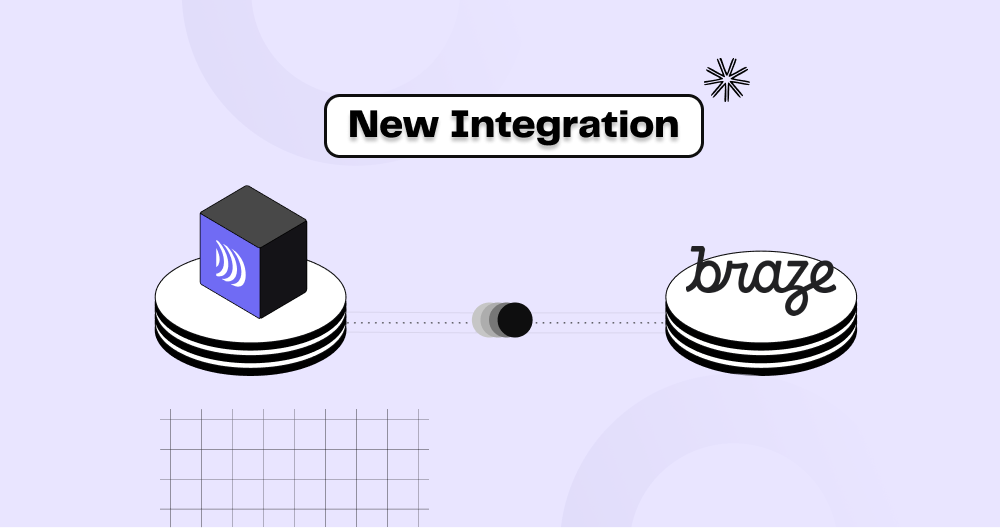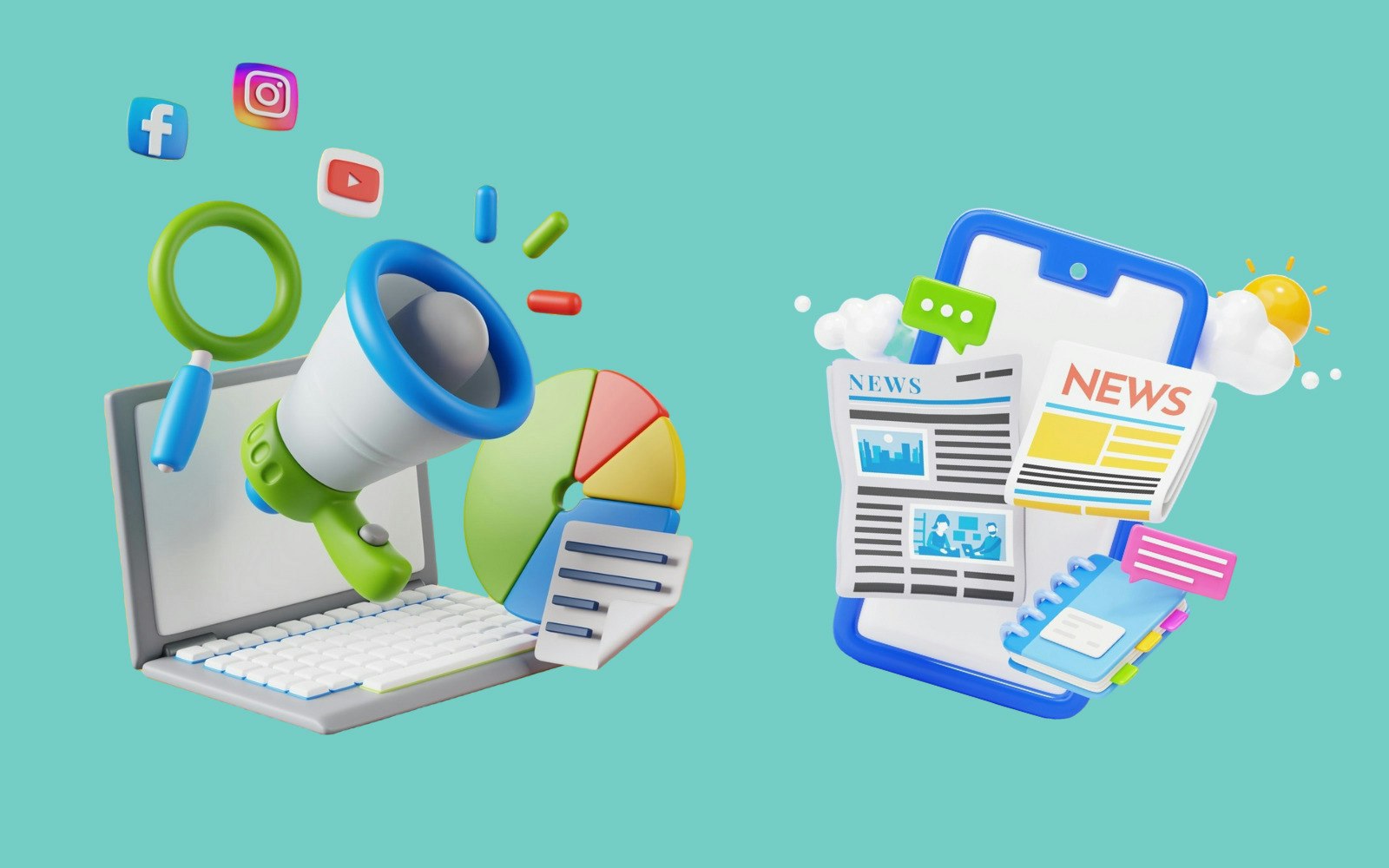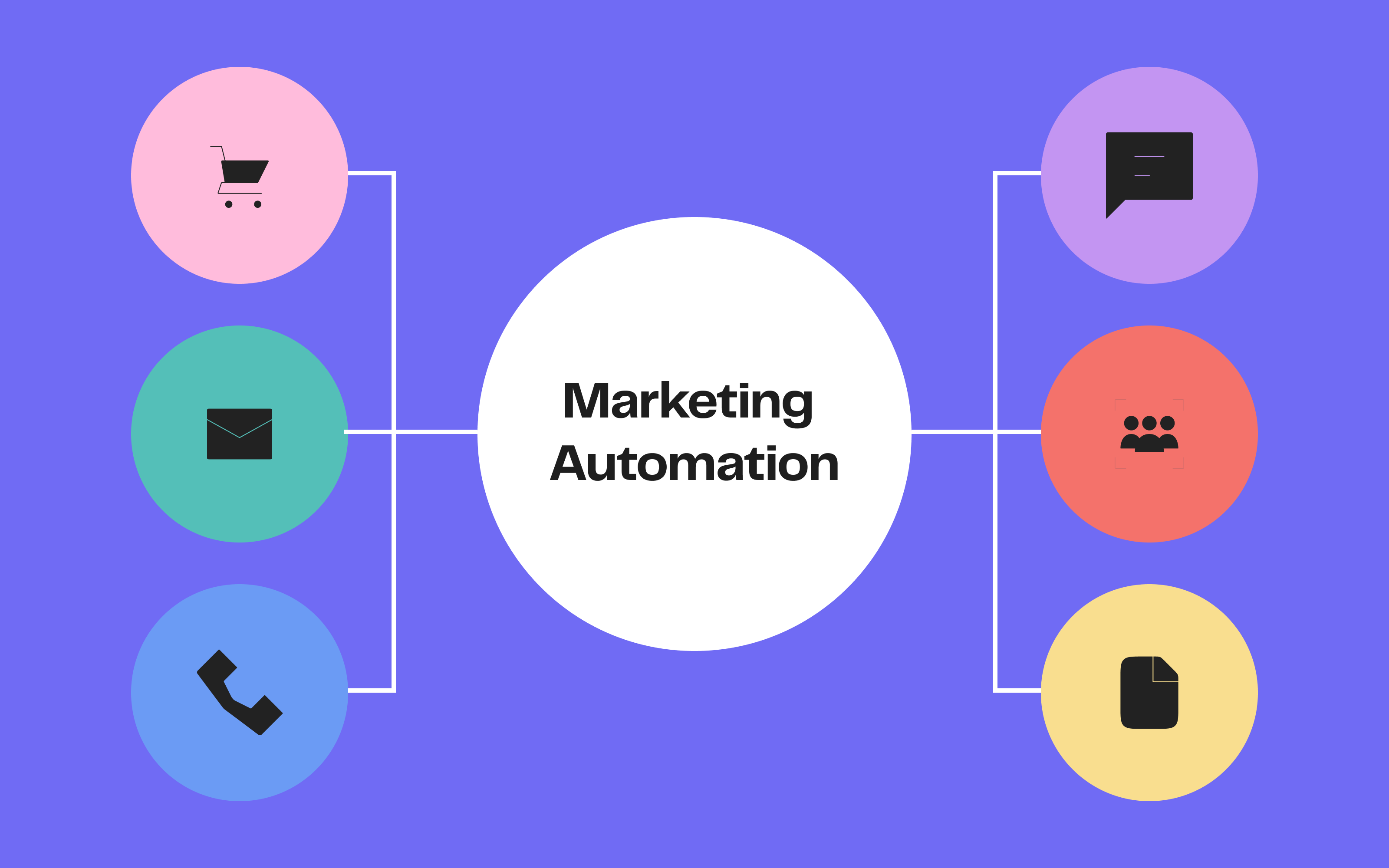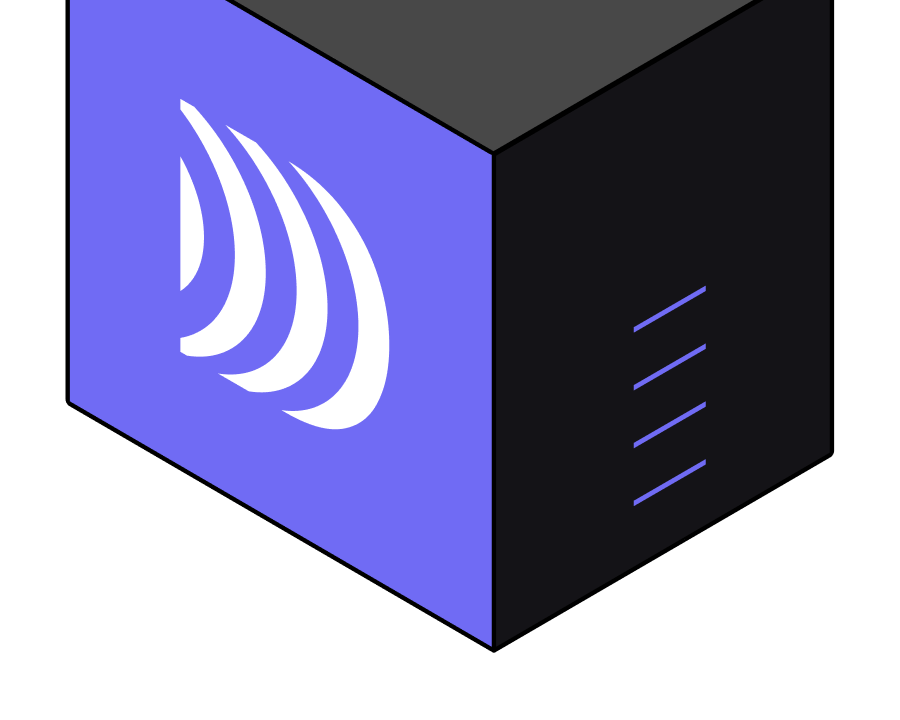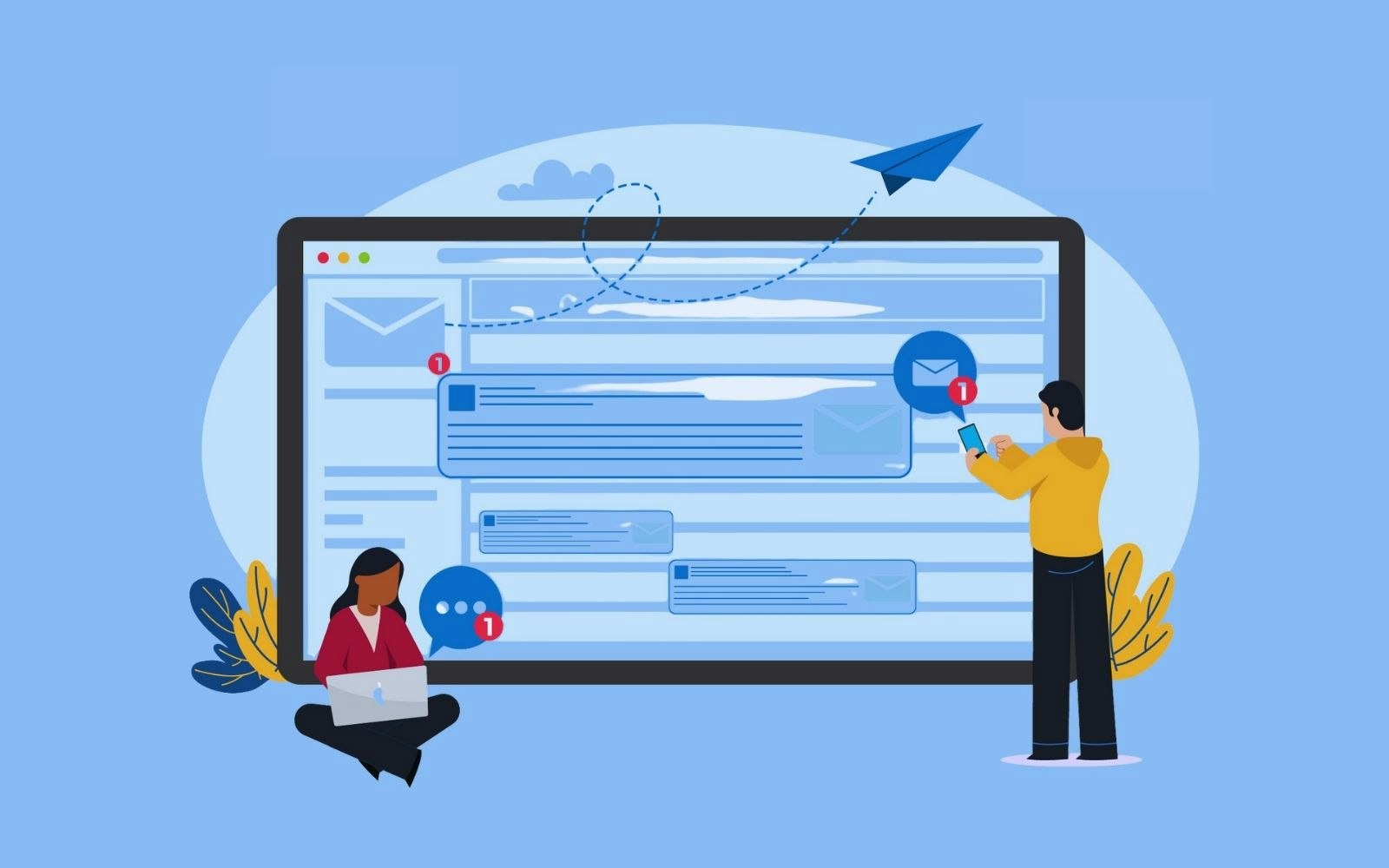
Crafting an effective, personalised follow-up email
8min • Last updated on Sep 29, 2025

Olivier Renard
Content & SEO Manager
[👉 Summarise this article using ChatGPT, Google AI or Perplexity.]
Around 376 billion emails are exchanged globally every day (Statista). A constantly rising figure for a medium created over half a century ago! Email remains an essential channel to re-engage or activate a customer.
Last year, nearly one in two consumers made a purchase via email (Marigold). In B2B, the same applies: 80% of sales require 5 to 12 follow-ups to close (HubSpot). Email is still a powerful ally for both conversion and loyalty.
Key takeaways:
A follow-up email is used to re-engage a prospect or customer by sending the right message at the right time. It’s useful in sales, marketing, accounting or human resources (HR).
Many follow-ups fail because they’re too generic, poorly targeted or mistimed. The key is knowing when and how to follow up.
Effectiveness relies on personalisation: a clear subject line, relevant content, appropriate tone and perfect timing. At scale, this requires the use of customer data.
A Customer Data Platform (CDP) helps automate follow-ups in an omnichannel environment, based on reliable and up-to-date data.
🔎 Discover what a follow-up email is, its use cases, and best practices to make it effective. How can data help you personalise your follow-ups and boost customer engagement? 💡
What is a follow-up email?
A follow-up email is a message sent after a lack of response or customer inaction. It aims to re-establish contact, encourage action or provide a reminder.
It can be used in various contexts, depending on the objective:
To get a response from a prospect or recruiter,
To re-engage an inactive contact,
To finalise a transaction (e.g. abandoned basket or pending quote),
To boost long-term loyalty through cross-sell or upsell.
When should you use it?
There are several types of follow-up emails. Sales follow-ups, common in B2B, are a basic tool for sales teams. Customer follow-ups, typical of B2C, are part of relationship marketing and aim to optimise interactions at every stage of the customer journey.
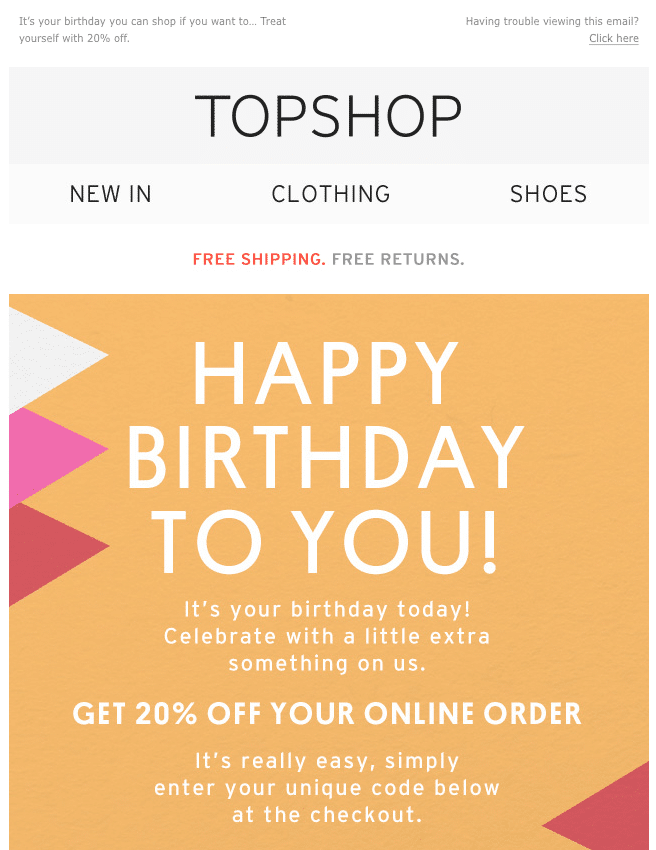
Topshop "Happy Birthday" Email
Invoice reminders are more administrative and should maintain a professional and factual tone. Finally, application follow-ups are used in an HR context to support the recruitment process.
The context also differs between B2B and B2C:
B2B sales cycles are longer and often require multiple follow-ups after the initial contact. The main challenge is building credibility.
B2C decisions tend to be faster. Follow-ups rely more heavily on data to trigger immediate action.
In both cases, follow-up emails must be relevant and personalised. They can be used at any stage of the journey: prospecting, conversion, retention or loyalty. They are a vital part of any effective relational strategy.
Use case | Objective | Example |
|---|---|---|
Follow-up after first contact | Get a response from a prospect | Email after meeting or unanswered quote |
Inactive customer | Re-engage and reduce churn | ‘We miss you’ email after 30 days of inactivity |
Abandoned basket | Finalise an e-commerce transaction | Reminder or limited-time discount offer to encourage purchase completion |
Unpaid invoice | Secure payment in a professional context | Polite reminder with the option of a discount for prompt payment |
Job application | Maintaining the relationship during a recruitment process | Follow-up email after a CV or interview with no response |
Main use cases for follow-up emails
Why follow-up emails are essential?
Every day, inboxes are flooded with millions of emails, ads, newsletters and notifications, creating a ‘content shock’.
In this saturated environment, grabbing the attention of a prospect or customer is a constant challenge. Competition is fierce, and recipients have little time to devote to each message (less than 9 seconds, according to a study by Litmus).
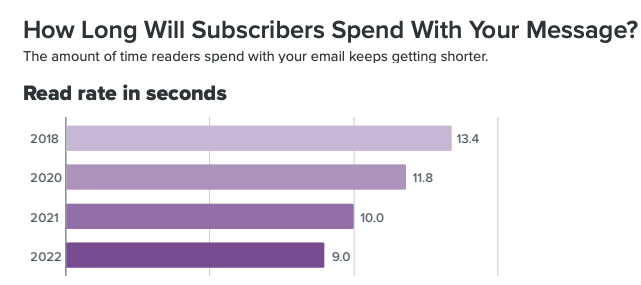
Email read rate in seconds (credit: Litmus)
Expectations have also changed significantly. Customers no longer pay attention to generic follow-ups or overly repetitive content. They expect personalised messages tailored to their needs and situation.
Timing is crucial. Sent too early, the follow-up feels intrusive. Sent too late, the opportunity is lost. For example, the conversion rate of a follow-up email after an abandoned cart drops sharply if it’s not sent within the hour.
In this context, first-party data provides valuable insights that make all the difference. It enables follow-ups to be triggered based on concrete signals: an abandoned basket, a period of inactivity, or purchase history.
In each case, customer data helps ensure precise targeting and avoids follow-ups that could be perceived as spam. With greater relevance, the email becomes a strategic tool enhancing the customer experience while strengthening brand loyalty.
How to write an effective follow-up email?
Your follow-up needs to capture attention within seconds.
1️⃣ The subject line is the first thing the recipient sees, so it’s a crucial element that deserves particular attention. It should be clear, personalised, and engaging without being intrusive or misleading. Highlight the benefit your customer stands to gain: this could be an advantage or a solution to a problem.
2️⃣ Personalisation is not optional: it determines whether your email succeeds or fails. Include the recipient’s first name, tailor the offer to their location, reference a recent interaction or the product they viewed to make the message more relevant.
3️⃣ The content must deliver added value. This could be useful information, a tailored proposal, or simply a clear answer to a query.
4️⃣ Each follow-up should also guide the recipient towards a specific action via a clear call to action — whether it’s booking a meeting, paying an invoice, visiting a page, or replying to the email.
5️⃣ Finally, the tone should align with your editorial guidelines, remaining both human and respectful.
Best practices and pitfalls to avoid
A few essential principles:
Keep it clear and concise: 100 to 150 words is enough.
Automate follow-up scenarios while maintaining a human touch to avoid robotic-sounding messages.
Get the timing right to follow up at the most opportune moment.
Ensure consistency across all channels (email, SMS, push notifications, ad campaigns).
Common mistakes include:
Overloading your recipient with too many follow-ups in quick succession.
Overlooking GDPR compliance (opt-in, right to withdraw).
Sending overly generic messages or those that don’t match the context.
Failing to analyse performance using key metrics (open rate, clicks, reactivation, ROI).
Inspiring follow-up email examples
A follow-up email can take many forms. Here are a few concrete examples showing how a simple reminder can become a powerful driver of engagement and loyalty.
Onboarding (welcome emails + follow-up)
The activation phase is particularly closely monitored by marketers. SaaS tools often excel in this initial dialogue with users. It’s typically the focus of a well-structured CRM campaign where every action is tracked.
A new customer who doesn’t complete their signup can quickly drop off. A reminder email helps finalise their profile or encourages them to try out a feature.
👉 Some companies to watch: Lemlist for its onboarding workflow, Slack for its guided message prompting teams to create their first channel.
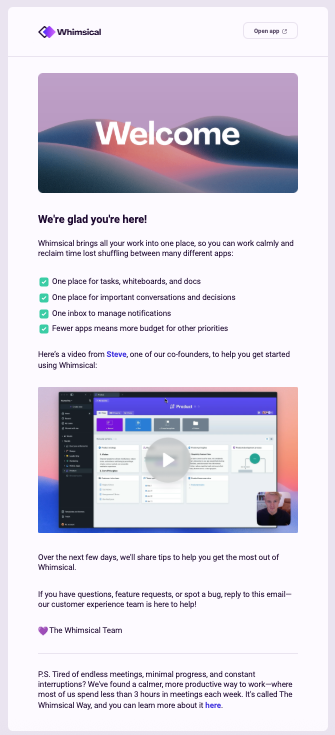
Whimsical welcome pack
Cross-sell / upsell (personalised recommendations)
Follow-ups aren’t only for reactivation – they can also boost customer value.
Amazon leads the way by suggesting complementary products based on purchase history. This strategy is now adopted by most e-commerce brands.
Abandoned basket (reassurance + incentive)
In e-commerce, a quick follow-up can make all the difference. A reminder of the product left behind, social proof or a time-limited discount helps drive the purchase home.
Asos combines a visual reminder of the basket with a clear call-to-action and sometimes a limited-time offer.
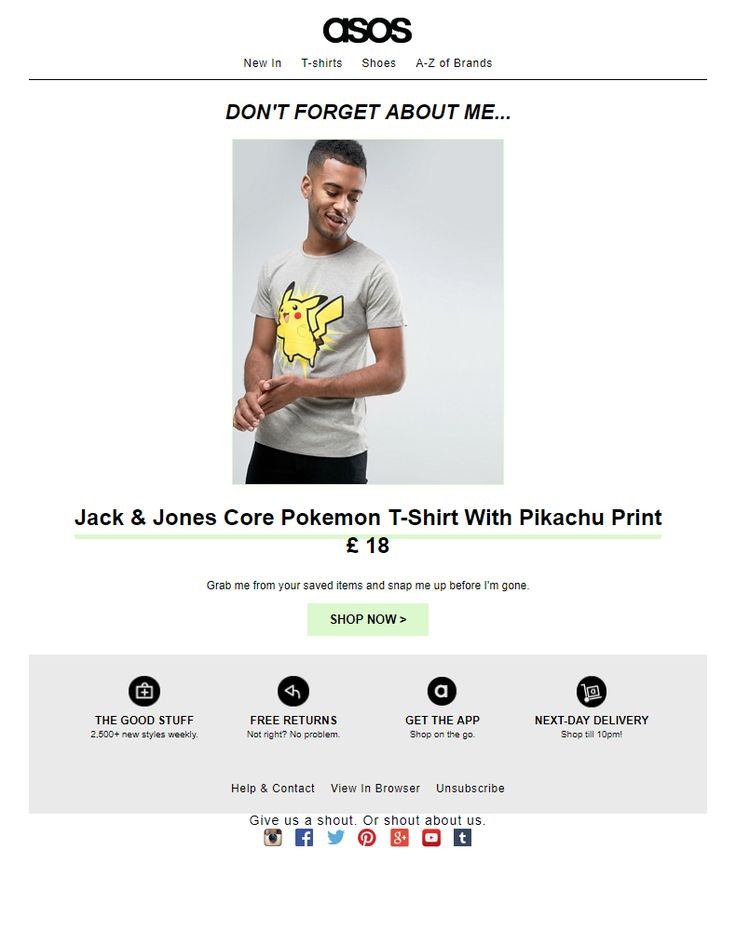
Email from Asos after an abandoned basket (credit: Pinterest)
Re-engaging inactive users (‘we miss you’)
A customer inactive for several weeks can be brought back with an empathetic and personalised message.
👉 Example: Deezer reaches out to subscribers with a humorous touch – sharing… their lack of stats! Meanwhile, competitor Spotify uses personalised playlists and premium return offers.
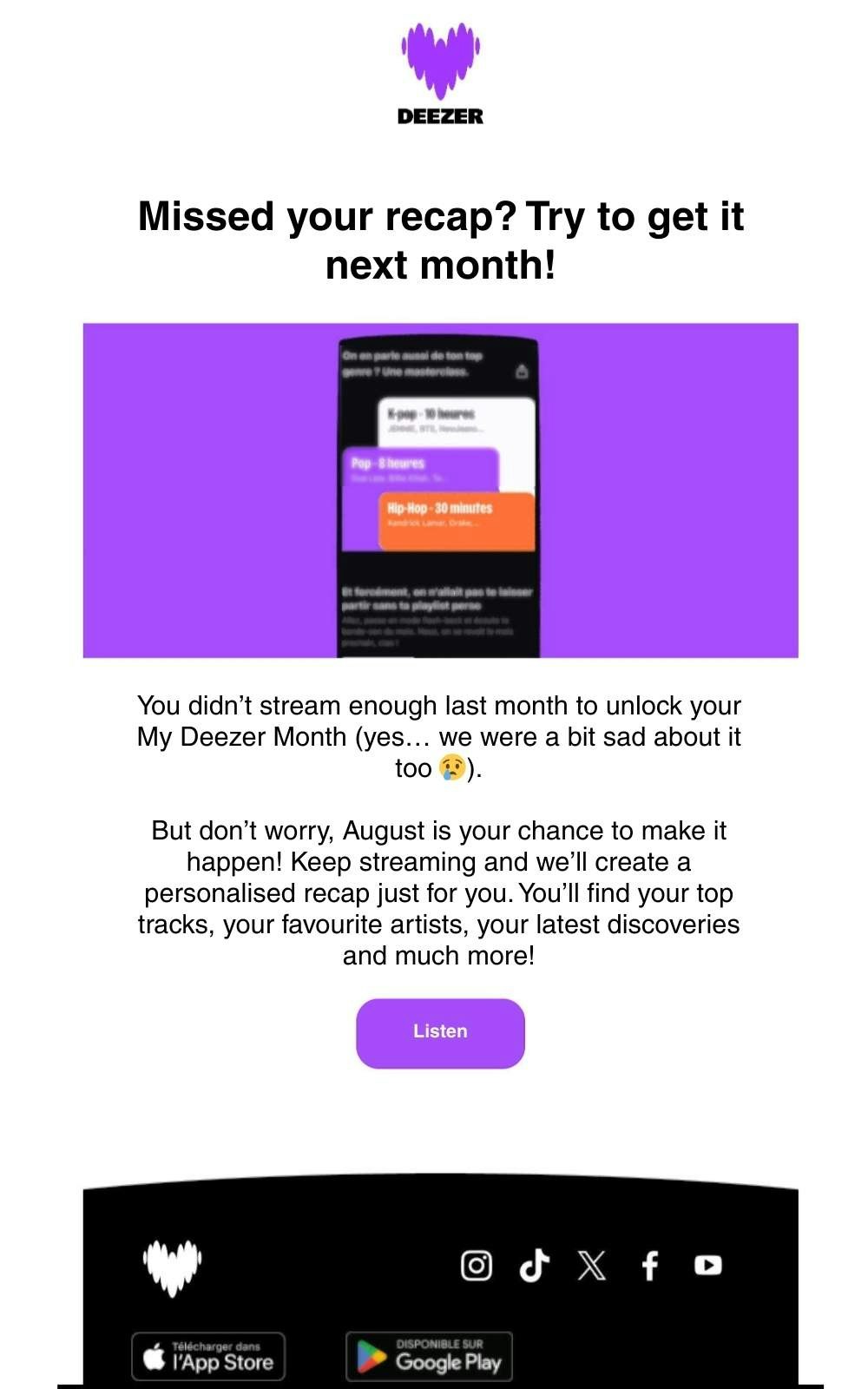
Monthly recap email from Deezer
Unpaid invoice (professional tone + clear and dated reminder)
A payment reminder should be firm but respectful. The goal is to preserve the relationship while securing cash flow. Solutions like Stripe make it easy to send automated emails politely reminding recipients of due dates and offering simple payment options.
Integrating follow-ups into a data-driven strategy
Standardised emails are often ineffective and less engaging, generating little real value. Unfortunately, personalising at scale in an omnichannel environment isn’t always straightforward.
In many organisations, data is scattered across the CRM, email platform, e-commerce tool or physical points of sale. This is precisely the mission DinMo has taken on: enabling business teams to access reliable, up-to-date, and actionable data.
It then becomes possible to tailor each message to the customer’s profile and behaviour, and send it at the most opportune moment.
Our Customer Data Platform (CDP) unifies customer profiles and allows you to create dynamic segments: warm leads, customers inactive for 30 days, or abandoned baskets. It then automatically triggers the right campaigns across the most effective channels — email, of course, but also SMS, push notifications or advertising platforms.
Key use cases of our CDP include:
Reactivating inactive customers using dynamic segments updated in real time.
Improving advertising performance by connecting first-party data directly to ad platforms via conversion APIs.
Increasing repeat purchases by re-engaging customers at the right time with the right offer.
Simpler to implement and modular by design, a composable CDP turns follow-up emails into a genuine performance driver. It enables brands to orchestrate interactions that are consistent, effective, and truly customer-centric.
Conclusion
A well-crafted follow-up email isn’t just another reminder in an overcrowded inbox. It’s a powerful lever to enhance the customer experience, boost retention, and directly increase ROI. Its impact relies on delivering a useful message, to the right person, at the right time, and in the right tone.
At scale, the effectiveness of follow-ups depends on data. DinMo unifies the customer data stored in your data warehouse. Our CDP helps you personalise your workflows, trigger campaigns at the most opportune moment, and strengthen consistency across your various channels.
💡 Put simply, data turns a simple follow-up email into a real growth driver for your business. Discover how DinMo can help you orchestrate your follow-ups and maximise the value of every interaction.
FAQ
When should you send a follow-up email?
When should you send a follow-up email?
The right timing depends on the context. In B2C, a follow-up after an abandoned basket should be sent quickly — often within the hour. In B2B, the appropriate delay might be a few days after an initial exchange.
The key is to be relevant without being intrusive, relying on concrete signals drawn from customer data.
How many times should you follow up with a prospect or customer?
How many times should you follow up with a prospect or customer?
It’s all about finding the right balance. Following up too little means missing opportunities; doing it too often risks annoying your contact.
In B2B, several spaced-out follow-ups are often needed to close a deal. In B2C, one or two well-targeted attempts are usually enough.
Tracking KPIs (opens, clicks, conversions) helps identify the ideal frequency.
What’s the difference between a sales follow-up and a marketing follow-up?
What’s the difference between a sales follow-up and a marketing follow-up?
A sales follow-up is generally led by the sales team, with a direct conversion goal, especially in B2B.
A marketing follow-up, on the other hand, fits into a broader customer relationship strategy: re-engaging, building loyalty, and increasing long-term value.
In both cases, first-party data helps tailor the message effectively.

















